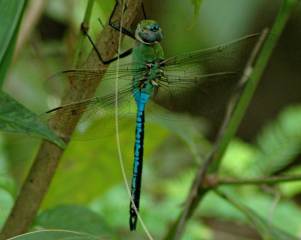Going through my old photo files has been fun for me; last night I found a slightly better photo of Coryphaeschna ingens, the Regal Darner [UPDATE:Gynacantha nervosa, Twilight Darner] who visited us during Tropical Storm Fay. I also ran across a couple of untagged photos of other species that I knew I’d seen, but couldn’t find in my files (lesson: ALWAYS apply photo tags). One of the untagged photos that I found is this Common Green Darner (Anax junius) that I saw on one of my lunchtime walks at Fern Forest:
I knew I’d seen these guys before, but I’d completely forgotten that I had taken a picture of one. I think the reason I didn’t tag it is that I was disappointed by the foreground palmetto string running through the image, so it wasn’t a “perfect” shot of the Common Green Darner. As the vernacular name implies, these dragonflies in the family Aeshnidae are quite common. Yesterday’s Regal Darner was also an aeshnid, but in a different genus.
The generic name of the Common Green Darner is Anax, which means king, lord, chief, master in Greek. Junius, I’m not so sure about, since it’s not in my go-to source (Brown, 1956), but it looks like a straightforward nominative form of Iunius, which is Latin for June: that would mean this species name translates to “June ruler,” presumably because it is so common in that month. It was described by Dru Drury in his 1773 Illustrations of Natural History.
According to Cannings and Stuart (cited in a natural history report from the Royal British Columbia Museum, which I found in the Wikipedia article on the name Aeshna), the family name Aeshnidae comes from a misprint of the Danish entomologist Fabricius’s original name for the genus, Aechma, from the Greek word meaning “spear.” That would mean the genus of yesterday’s dragonfly, Coryphaeschna, is a compound word, formed from this word and another Greek word, corypho, “head, top”: “spearhead.” The French entomologist Jules Pierre Rambur described that species, the type specimen for the entire genus, in his 1842 Histoire naturelle des insectes, part of the Suites à Buffon.
I’ve not yet found any source to corroborate my speculations above, so if anyone knows where I can find out more, I’d appreciate hearing about it!
References
Brown, R.W. (1956). Composition of Scientific Words: A Manual of Methods and a Lexicon of Materials for the Practice of Logotechnics. Washington, DC: Smithsonian Institution Press.
Cannings, R.A. & Stuart K.M. (1977). The Dragonflies of British Columbia. British Columbia Provincial Museum Handbook No. 35, Victoria, B.C.
Catalogue of the Odonata of the world.

